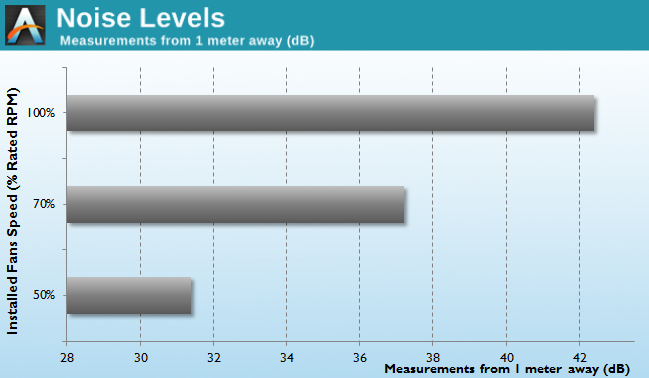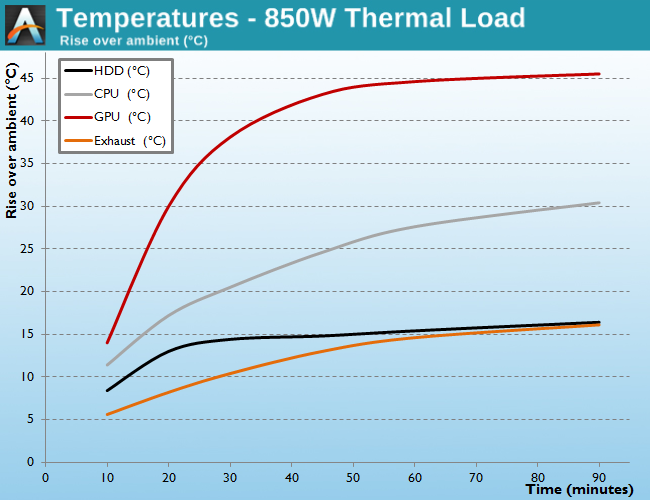Nanoxia Deep Silence 6 Review
by E. Fylladitakis on February 13, 2014 3:00 PM EST- Posted in
- Cases/Cooling/PSUs
- Full-Tower
- HPTX
- Nanoxia
- Case
Test Setup
As noted in our Corsair Obsidian 250D review, we've reworked our computer case testing methodology to improve how systems are tested. This is our first ATX (or larger) case with the new setup so we don't have any comparitive results. Let's quickly go over the basics of our new methodology.
Professional testing requires the simulation of real-world workloads but with repeatable results; this means that a perfectly controllable test setup and environment are required, especially for truly comparable results. Testing the thermal performance of any case with a real-world PC setup technically limits the comparability of the results to that configuration alone, as an active system interacts with its environment and the change of a single component alters many variables.
To accomplish this, we've developed synthetic loads that simulate the thermal output of real systems, with the benefit being that the outputs and loads are passive, steady, and quantifiable. This will allow us to focus on the thermal capabilities of the case alone, as the case has to deal with the entire thermal load by itself, regardless of the system that would be installed inside it.
Laboratory data loggers are used to monitor the PT100 sensors and control the safety relays, which are fully accessible via our custom software. Three such loads have been developed for testing cases: mini-ITX, micro ATX, and standard ATX; we'll use the latter here. The ATX workload simulates a 200W CPU, 50W VRM, 30W RAM and 4 × 120W GFX card thermal load. Finally, three 3.5" HDD dummy loads have also been created, with each of them converting 30W of electrical power to thermal, bringing the total thermal load of the ATX test setup up to 850 Watts.
This is a rather extreme thermal load designed to "separate the men from the boys" as it were, and only the best of cases will be able to handle it for more than a few minutes. We also have a second less extreme workload that consists of a thermal load of 400W, with all of the aforementioned components except the HDD drives at about 42% power, which is more suitable for the majority of cases.
Thermal testing has been performed with all of the case's stock fan operating at maximum speed. Noise testing has been performed with a background noise level of 30.4dB(A).
Results and Discussion
As expected, the thermal performance of the Nanoxia Deep Silence 6 is exceptional. Even with a thermal load of 850W, the temperature readings stabilize relatively quickly, indicating that the stock cooling options of the case can cope with massive thermal loads without the temperatures rising too far above ambient. The space, multitude of ventilation openings, and ample airflow of the stock 140mm fans are sufficient for a continuous thermal load of 850W over 90 minutes.
The temperature of the HDD drives stabilize very quickly and at low temperatures, as the intake fans blow right at our dummy HDD thermal loads. Similarly, the temperature within the GPU area stabilizes quickly, only this time at relatively high temperatures due to the lack of any direct airflow. (Note that blower-style GPUs could help here.) The CPU area meanwhile is caught in the wake of the top and rear exhaust fans, and thus takes the longest time to stabilize but does so with very good final readings.
The temperature of the air exiting the case at the end of our test is at 34.2 °C, 16.1 °C over ambient This is an excellent figure for such a massive thermal load, though this will become more noticeable as we test additional cases; for now you'll have to take our word for it.
Reducing the load down to 400W simply demonstrates the enormous thermal inertia of the gigantic case, which outside of the HDD loads has not stabilized even after several hours of testing. This is part of the reason for using such a large thermal load, as it helps to more quickly distinguish the cooling capabilities of various cases.

The noise levels of the Nanoxia Deep Silence 6 are not as low as we expect from a case with such a name. The five 140mm fans are easily audible from one meter away, with the meter displaying over 42 dB(A). In real-world terms, the Deep Silence 6 is not overly noisy, yet it's clearly audible with all of its fans running at 100%. It's likely that a fair percentage of users might find it overly loud for everyday usage.
After reducing the speed of all installed fans down to 70%, the noise level drops significantly, down to just over 37 dB(A), which equals to a drop of over 50%. After the first speed drop, the case remains audible but comfortable for all but the most sensitive eared users. Finally, halving the speed of all the cooling fans drops the noise levels dramatically, below 32 dB(A), making the Deep Silence 6 very discreet though not yet inaudible in a perfectly quiet environment.
We should note that closing the "chimney", which shuts down the top 140mm fans, has a dramatic impact on the noise levels of the case as well, dropping it down to 32.4 dB(A) with the rest of the fans running at maximum speed. That of course will also reduce the thermal performance of the Deep Silence 6, which may not matter much when you're not running a heavy load on the system, especially considering the size of the case and the remaining ventilation. However, this is not a viable option if a liquid cooling radiator has been installed on the top panel. Obviously reducing the fan speeds will also affect thermal performance, but ultimately the DS6 can cater to either end of the noise/cooling spectrum.












26 Comments
View All Comments
SodaAnt - Thursday, February 13, 2014 - link
Looks like a good case. However, I'm not sure if its just me, but the titles on those graphs just look blurry to me. Also, that's the first time I've ever seen minutes of a degree so casually used in a review, I had to do a double take to make sure I was understanding it right.ddriver - Thursday, February 13, 2014 - link
Yes, looks like it is not the optimal edge smoothing method for this combination of colors and font.JarredWalton - Thursday, February 13, 2014 - link
I think Tracy made the charts manually in some other program (Excel?), and perhaps they got resized somewhere along the way. We'll try to avoid blurry images/fonts next time. :-)noeldillabough - Thursday, February 13, 2014 - link
I love giant cases; easier to put things in and take things out of! That said I wish the exhaust was out the top like the TJ11, to me once I got used to it, exhausting out the top was the superior option.I too would like wheels but the case is already very tall; are there any low profile rollers we could put underneath (no way we'd fit regular wheels under there)
The PC Apologist - Thursday, February 13, 2014 - link
Exhausting out the top is indeed the superior option since as hot air naturally rises, why not go with the flow?That said, the option to exhaust via the top is present. There are two lids on the top that can be raised or lowered. Once raised, it will also hot air to escape via the sides.
lever_age - Thursday, February 13, 2014 - link
Convection has next to zero effect compared to forced airflow with the fans we're talking about here. Orientation doesn't really matter. If you flip one of these cases so the back is now the top or so, you get almost exactly the same temperatures, just maybe a degree off, as shown in tests.The PC Apologist - Thursday, February 13, 2014 - link
Yes I know, the difference in temperatures is negligible. It has always upset me that the temps don't show a larger difference.And yet, because it should theoretically be better, isn't it enough to convince you to choose top over rear?
All else being equal, let's go with the flow.
But if there's a sufficient reason to choose the rear, the rising hot air thing is easily defeated.
lever_age - Thursday, February 13, 2014 - link
No, you may need some special provision (extra height so extra volume overall) to allow sufficient intake from the bottom and exhaust out the top. If you do a layout with motherboard I/O facing up, having cables stick out perpendicular to the ground means more volume or some kind of messiness or contraption to guide them out horizontally. If you have exhausts on the top, dust can readily fall in when the system is not in use.Though depending on layout and restrictions of your living area, some arrangement using top exhaust could be nicer. It just usually doesn't seem as sensible.
JarredWalton - Thursday, February 13, 2014 - link
Best thing about orienting the motherboards 90 degrees rotated is that your GPUs (and in theory expansion cards) hang down from the case and this greatly reduces the stresses on the GPUs, PCIe slots, and motherboard. But simply exhausting out the top without rotating the motherboard doesn't really make much of a difference.Gigaplex - Thursday, February 13, 2014 - link
And then you get your display cables et al sticking out the top of the case rather than the back. Convenient, but ugly. The Silverstone FT03 has an interesting compromise to work around that, however the convenience factor is largely lost.